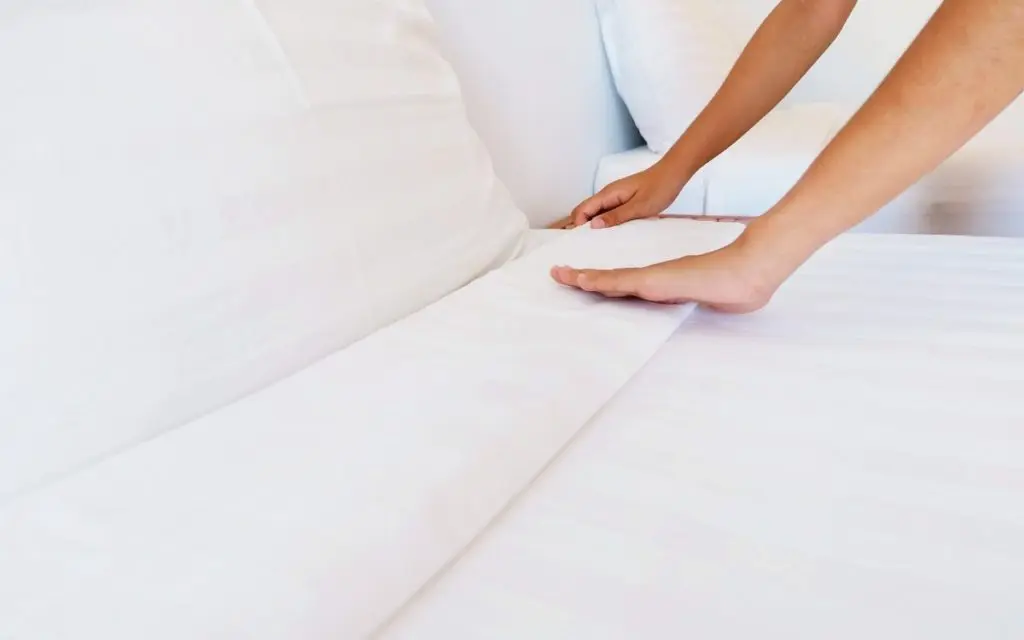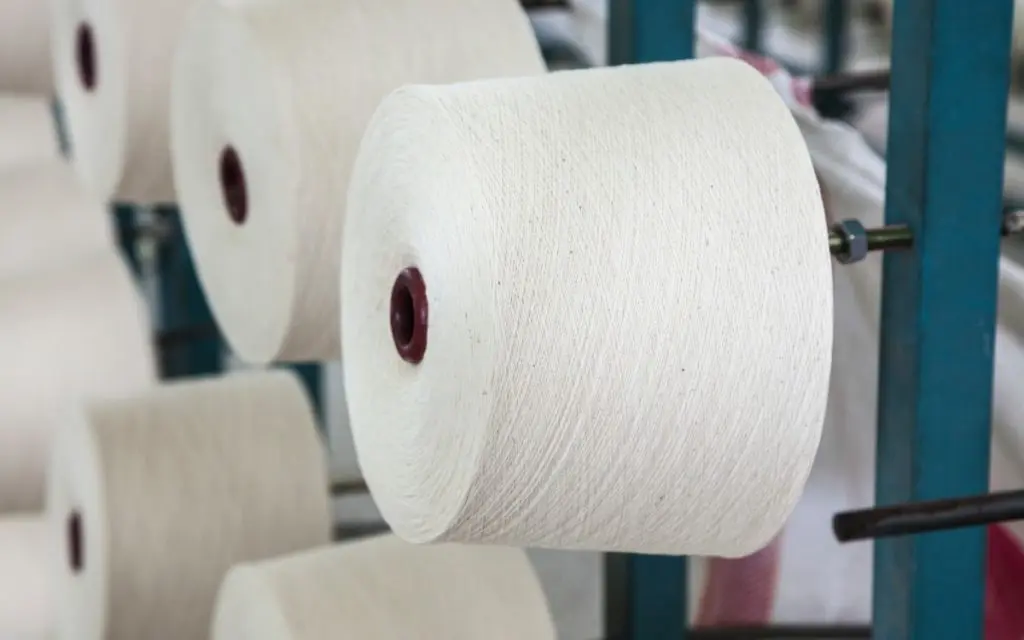In this article, we’re going to take a hard look at the two most popular kinds of bedsheets: microfiber vs. cotton sheets. And yes, we’ll even explore the fancy Egyptian cotton options you’ve heard about.
Picking the right sheets for your bed can make all the difference between a good night’s sleep and a tossing-and-turning night’s sleep. But with all the different styles, fibers, and thread counts out there, how are you supposed to know which ones are best?
| Microfiber Sheets | Cotton Sheets |
| • Extra-soft • Retains temperature • High durability • Moisture-wicking • Less expensive • Synthetic material | • Gets softer with every wash • Breathable • Natural fibers eventually break down • Retains moisture • Moderately expensive • Natural material |
Cotton vs. Microfiber: What Are They?
You might already know this, but let’s take a quick overview. Cotton sheets are made with fibers from the cotton plant, which is a natural material. Microfiber sheets are made with synthetic fibers that do not come from a natural source. These fibers are thinner than cotton fibers (hence the name microfibers) and usually feature a tighter weave than cotton.
That’s it — that’s the difference. So now, let’s compare.
Softness

Softness is often the first thing you think of when you’re considering which sheets to buy. After all, you’re going to lie on top of them, and wrap up in them — you want them to be comfortable, and gentle against your skin. When it comes to softness, microfiber and cotton are on a pretty level playing field. Theoretically, microfiber sheets are softer than cotton sheets, as their fibers are thinner. The closer together the individual fibers are, the softer the feel.
The fly in the ointment here is that there are different thread counts for both microfiber and cotton sheets. A low thread count microfiber sheet might not feel as soft as a high thread count cotton sheet. But, if you have the same thread count, microfiber will be softer to the touch.
Winner: Microfiber. Though the difference in thread count may impact softness, in general, microfiber is softer than cotton thanks to ultra-thin fibers.
Breathability
Softness may be the first thing to consider, but breathability is the second; the last thing you want is to wake up at 3 AM, all hot and sticky because your sheets are stuffy.
Unfortunately, breathability and softness are a double-edged sword. Remember how microfiber is softer thanks to its super-thin fibers in a tight weave? Well, those fibers being so close together also limits how breathable the fabric can be. Cotton, on the other hand, has thicker fibers that aren’t as close together, making it extremely breathable—but not as soft.
Winner: Cotton. Cotton fibers are thicker and less close together than microfiber, making cotton sheets more breathable than microfiber.
Moisture-Wicking
Breathability isn’t the only thing to keep in mind when you’re worried about waking up hot and sweaty. While you don’t want your sheets to trap heat in with you, you also you’re your sheets to wick away any moisture you do happen to sweat out.
By wicking away moisture, we mean material that allows moisture to evaporate quickly. Moisture-wicking is the difference between damp, sticky sheets and crisp, dry sheets.
We won’t bore you with the science, but basically, synthetic materials are much better at wicking away moisture than natural cotton. Microfiber sheets are better at moisture-wicking than cotton sheets. However, it’s worth noting that cotton sheets are generally more breathable than microfiber sheets, and don’t trap as much heat. Less heat means less sweating, which means less moisture to wick away.
Winner: Microfiber. Cotton retains less heat. You might sweat less with cotton, but microfiber sheets are still better at wicking away moisture when you do sweat.
Durability

Let’s talk longevity. Bedsheets aren’t exactly cheap, so when you invest in a set, you want them to last. When it comes to durability, cotton sheets don’t always step up to the plate. The natural fibers break down over time, and every run through the washer and dryer speeds up that process. The benefit of this is that, with every wash, your cotton sheets will get softer and softer as the fibers lose their rigidity. The drawback to the softness is that eventually, you’ll end up with holy sheets.
On the other hand, the engineered synthetic fibers in microfiber sheets will survive rough tumbling around in the wash. Microfiber sheets are also generally woven tighter than cotton, meaning the weave is less likely to unravel under stress. While this means they’ll last a long, long time, it does also mean your microfiber sheets won’t necessarily get softer with each wash as cotton sheets do.
Winner: Microfiber. While washing makes cotton sheets softer, it also breaks down the natural fibers. Microfiber sheets use tighter weaves and more durable fibers that will last through more washes.
Care
Both microfiber and cotton sheets are pretty easy to care for. They are both washing machine and dryer safe. While microfiber is more likely to stain than cotton, both take well to stain removers. Both fibers retain color and pattern well. Cotton might shrink its first time through the dryer but will get softer after every wash.
In contrast, microfiber won’t shrink but also won’t get softer. Cotton is more prone to wrinkling than the wrinkle-resistant microfiber, but this doesn’t matter to most people when it comes to sheets. You can iron sheets, so if it does matter to you, you can easily fix the issue.
Winner: Tie. Microfiber and cotton are both machine washable and dryer-safe, take well to stain removers, and can be ironed if wrinkly.
Microfiber vs. Cotton: Natural vs. Synthetic
We’ve used the word synthetic a bunch of times now. A big concern for consumers is often whether or not there are long-term health concerns when it comes to choosing synthetic fibers over natural cotton ones. There’s a lot of discussions, and not a whole lot of actual studies. But here’s the overview: basically, those who advocate for natural fibers are concerned that the harsh chemicals used in the production of synthetic fibers will absorb into the skin and cause health problems. These problems can include basic skin irritation, but there is also some concern about cancerous implications.
According to the research on this issue… basically, there’s not enough research. There is proof that certain chemicals from synthetic materials can and will absorb into the skin after prolonged exposure (the study proving this used 24-hour periods). There is no indication that this absorption is harmful, or that it has any lasting impact. Still, there haven’t been enough long-term studies to say there’s no chance of health problems conclusively.
Researchers do seem to universally agree that the threat of chemical transfer significantly reduces after washing. Basically, they recommend you wash your sheets when you first bring them home, and then you’ll be fine.
Winner: Tie. While there are more chemicals used in the production of synthetic fibers than in the harvesting of natural fibers, simply washing sheets before using them the first time is sufficient to all but eliminate the threat of chemical transfer to your skin.
Environmental Impact

In addition to the health concerns mentioned, the microfiber vs. cotton sheets debate also encompasses the environmental impact that both kinds of fibers produce. Cotton, as a natural and renewable resource, is often championed as the more environmentally-friendly. However, cotton does take up lots of real estate to grow, and it uses lots of water during processing. Cotton will break down and need replacing faster than synthetics.
Synthetic materials take up less physical space, as they aren’t grown. However, they require more chemicals and fossil fuels during production. These chemicals contribute to both the depletion of non-renewable resources and general pollution. However, these materials are incredibly durable and infrequently need replacing. One set of microfiber sheets may substitute for two or three sets of cotton sheets.
With the recent trend of “going natural,” cotton and other natural fibers have risen in popularity. This has led to irresponsible production, including the destruction of forests and the abuse of low-wage workers. Suppose you’re concerned about your carbon footprint and want to go with a natural sheet choice. In that case, you may want to research companies. Ensure they follow ethical business practices, are certified Fair Trade, and source their materials responsibly.
Winner: Tie. The production of both microfiber and cotton sheets can negatively impact the environment, either through the use of fossil fuels or the irresponsible obtaining of cropland. Researching and choosing a responsible, ethical, and environmentally-conscious company is the best way to reduce environmental impact.
Microfiber vs. Cotton: Affordability
The cost of microfiber and cotton sheets depends on the quality of the material and thread count. If you look at a set of each with the same thread count, you’ll most likely find the microfiber to be cheaper. High-end cotton sheets are also available, such as Egyptian cotton sheets, which are much more expensive than regular cotton sheets.
Winner: Microfiber. In general, microfiber sheets cost less than cotton sheets of the same thread count.
Microfiber vs. Egyptian Cotton
Before we go, let’s talk about Egyptian cotton. Many consider Egyptian cotton the “elite” of the bedsheet kingdom because it comes from a unique species of cotton known as Extra-Long Staple (ELS) cotton. Basically, this just means the fibers are longer, making the weave more seamless, softer, and more durable. Some also say that because Egyptian cotton is generally picked and processed by hand rather than with large machinery, it retains the fibers’ structural integrity. There’s no research to back this up, but it certainly sounds reasonable.
Either way, Egyptian cotton is generally much more expensive than “regular” cotton. It’s considered exotic (it does come from Egypt) and sells for much more than other high-end cotton sheets. But Egyptian cotton is still cotton at the end of the day, which means it will eventually break down, just like regular cotton. It also means it may shrink in the dryer, it’s more breathable but not moisture-wicking, and it’s natural. Egyptian cotton may be more durable than regular cotton, but still won’t be as durable as microfiber. It will undoubtedly be more breathable than microfiber, but won’t wick away moisture. Think of it as the best of the best when it comes to cotton, but still consider it cotton for the comparisons we’ve made in this article.
Winner: Tie. When it comes to microfiber vs. Egyptian cotton sheets, Egyptian cotton is still cotton, and has the same benefits and drawbacks as regular cotton compared to microfiber.
Which Is Best?
Overall, when you compare microfiber sheets to cotton sheets, there are pros and cons on both sides. It depends on what you’re looking for, what you can afford, and what’s important to you. If you sweat a lot, moisture-wicking is probably a top priority. If money is no object, your skin will thank you for investing in a set of luxurious Egyptian cotton sheets.
Either way, both materials will make for a comfortable night’s sleep so that you can seize the day with a well-rested smile!
Further Reading






